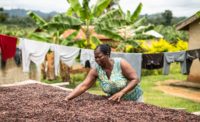
Executives from Blommer Chocolate Co. discussed the state of the cocoa industry at its 9th annual commodity and purchasing seminar in Chicago. Topics included the cocoa supply situation, developments at origin, differentials, social responsibility, cocoa demand, product ratios and the cocoa price model, technical analysis of the market and an update on sugar and dairy costs.
The recession was a dominant thread in the conversation. Despite the economy, Blommer is doing well, thanks in part to “unforecasted demand,” reported President and Chief Operating Officer Peter Blommer. As a result, the company’s plants are “running full out.” In short, Blommer is about 4% ahead of plan (June-September); however, that may or may not be indicative of the industry as a whole, the coo pointed out.
Sustainability was another thread in the seminar. For example, Blommer has announced a partnership with the Rainforest Alliance to bring certified, sustainable cocoa to the industry while benefiting farmers. And it is one of several companies participating in Ghana’s Cocoa Livelihoods Program, funded by the Bill & Melinda Gates Foundation.
The chocolate industry is dependent on the production of cocoa trees and their pods, which contain much-needed cocoa beans. Nearly 40% of production comes from the Ivory Coast in West Africa, followed by Ghana at 21% - but production in the latter is plateauing, according to Kip Walk, director of cocoa for Blommer and chairman of the World Cocoa Foundation. Although production in Ecuador spiked with the introduction of single-origin and high cocoa mass chocolates, it actually is a small (3%) producer of cocoa. The Ivory Coast remains the focus.
“This part of the world is crucial for us today and probably will be for years to come,” Walk stated.
Unfortunately, issues in the Ivory Coast have driven supply down, while demand remains strong, resulting in higher prices. For example, it takes four months for a cocoa pod to fully mature, Walk explained, and while there currently is an abundance of ripe cocoa pods, there is a lack of mature trees. Thus, the last of the Ivory Coast cocoa shipments will come in February. Although better pricing for farmers is helping them to invest back in their farms, that action won’t manifest into more crops right away. Black pod disease is another problem affecting production. New techniques such as side-grafting are enabling farmers to recreate growth from the best of its trees.
Blommer also has made efforts to increase and improve production in Indonesia, which accounts for 13% of the cocoa supply. Production there is threatened by a moth called the cocoa pod borer. But training programs that are teaching farmers to strengthen the cocoa pod, for example, have resulted in great improvements throughout the community.
On the demand side, said Sheila Fortune, commodity hedging manager for Blommer, the issue is grind, i.e. the conversion of beans into products. Western Europe and the Americas are the first and second leaders, respectively, in terms of grind. Worldwide, about 625 metric tons are predicted for next year for a 2.7% increase over 2009, but those numbers are down from recent years.
At retail, consumption of chocolate also is down, Fortune noted, especially for large bars. But she predicts a rebound in consumption, post-recession, including in the premium sector.
“Chocolate is recession-resistant, but not proof,” Fortune said.
The prices of cocoa, sugar and milk are up. Sugar production has been greatly impacted by bad beat crops as a result of poor weather conditions, explained Jeff Rasinski, director of commodities for Blommer. Although Idaho, Michigan, Minnesota and North Dakota are recovering, California is not. Mexican imports of sugar will increase in 2010 following its massive export of sugar this year (due largely to the value of the peso). Canada is one source of more affordable sugar, Rasinski pointed out, and although India is the largest consumer of sugar in the world, Brazil is the largest producer.
As for milk, Rasinski asserts that companies should just close their eyes and buy it. As an increasing number of herds are “retired,” milk production has fallen, resulting in higher prices as well as imports of cheap butter fat, plus a lot of cash and carry.
Blommer also held commodity and purchasing seminars in Philadelphia and Union City, Calif. For more information, visitwww.blommer.com.





